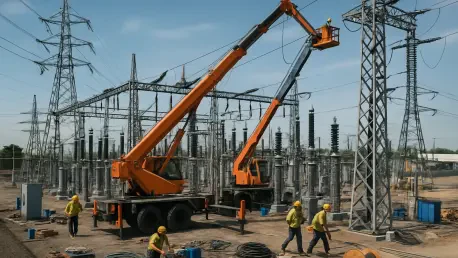When a hurricane tears through Houston, leaving millions in the dark for days, the fragility of Texas’s electric grid becomes painfully clear, and the impact is devastating. Picture entire neighborhoods without power, businesses shuttered, and families struggling to keep food from spoiling in the sweltering heat. This isn’t a distant nightmare—it’s a reality many Texans have faced during storms like those that have battered the state in recent years. Now, a monumental decision by Texas regulators to approve a $2.7 billion resiliency plan for CenterPoint Energy offers a glimmer of hope. This isn’t just about fixing wires; it’s about rewriting the future of energy reliability for a state often at nature’s mercy.
Why This Massive Grid Upgrade Captivates Texas
The stakes couldn’t be higher for Texas, a state where extreme weather has repeatedly exposed the vulnerabilities of its power infrastructure. The approval of CenterPoint Energy’s $2.7 billion plan by the Public Utility Commission of Texas (PUCT) on August 21 marks a turning point. Serving the Houston area, CenterPoint is tasked with protecting over 2 million customers who have endured prolonged outages during hurricanes and other disasters. This plan isn’t a mere patch job—it’s a comprehensive strategy to harden the grid and prevent the cascading failures that have cost the state billions in economic losses. For Texans, this investment signals a potential end to the dread of flickering lights when storm clouds gather.
Beyond the numbers, the significance lies in the promise of stability. With projections estimating that the plan could prevent over 755 million outage minutes, the impact on daily life and commerce is profound. Imagine hospitals maintaining critical care, schools staying open, and small businesses avoiding ruin during the next big storm. This initiative, spanning from now through 2028, represents one of the largest utility resiliency efforts in Texas history, setting a benchmark for how the state tackles its energy challenges head-on.
The Dire Need Fueling Texas’s Energy Resilience Drive
Texas has been schooled by Mother Nature’s wrath, with recent storms leaving deep scars on its power grid and collective psyche. Millions have sat in darkness for days, grappling with spoiled food, stifling heat, and disrupted lives. These recurring crises spurred a legislative mandate a couple of years ago, compelling utilities to develop detailed plans to fortify their systems. CenterPoint, at the epicenter of Houston’s storm-prone region, emerged as a key player in this statewide push to ensure that power outages don’t become synonymous with every weather event.
The urgency isn’t just about past failures—it’s about future risks. As climate patterns intensify, the likelihood of severe storms grows, making grid resilience not a luxury but a necessity. For communities and local economies, the difference between a grid that collapses and one that endures could mean avoiding billions in damages. This backdrop of vulnerability and legislative action framed the intense focus on CenterPoint’s proposal, positioning it as a critical test of Texas’s resolve to safeguard its energy future.
Unpacking the $2.7 Billion Blueprint for Power
At the heart of the PUCT’s approval lies a meticulously revised plan, whittled down from an initial $5.75 billion proposal to a more palatable $2.7 billion after months of negotiation. This budget, finalized for implementation between now and 2028, funds over two dozen projects aimed at toughening infrastructure. Stronger poles, reinforced wires, and advanced technology to detect faults faster form the backbone of this effort, targeting the most storm-vulnerable areas in Houston.
A significant chunk of the plan focuses on vegetation management, shifting from a five-year to a three-year tree-trimming cycle to reduce the risk of fallen branches knocking out power lines. This adjustment alone could prevent countless outages, given that overgrown trees often exacerbate storm damage. Compared to other Texas utilities like Oncor Electric, which secured a $3 billion plan last year, CenterPoint’s approach is tailored to its unique urban and coastal challenges, balancing scale with specificity.
The projected outcomes are staggering—CenterPoint estimates that these upgrades will avert massive disruptions, enhancing reliability for millions. Yet, the journey to this approval wasn’t smooth, with regulators slashing costs to ensure ratepayers aren’t overburdened. This final $2.7 billion figure reflects a compromise, prioritizing impactful projects while keeping affordability in check, setting a precedent for how utility investments are scrutinized and shaped.
Regulatory Rigor and Utility Resolve in the Spotlight
The path to approval was marked by sharp debate and critical oversight from Texas regulators. Commissioner Courtney Hjaltman of the PUCT emerged as a key voice, pressing for transparency on how funds, especially for vegetation management, would be spent. “Clarity is essential on what truly enhances resilience versus what’s just standard upkeep already covered by rates,” she argued during deliberations. Her pointed concerns led to budget reductions, ensuring that every dollar approved targets strategic grid improvements rather than routine tasks.
CenterPoint, for its part, stood firm on the necessity of the plan, expressing readiness to break ground this fall. “Protecting our customers from the next storm is our priority, and we’re prepared to deliver on this commitment,” the utility stated following the PUCT’s unanimous 3-0 vote. This dynamic between regulatory caution and corporate determination underscores a broader tension in Texas’s energy sector—how to fund ambitious upgrades without placing undue strain on consumers.
The dialogue also revealed a collaborative undercurrent, as both sides worked toward a shared goal of resilience. Regulators’ insistence on detailed justifications pushed CenterPoint to refine its proposals, while the utility’s persistence ensured that critical projects weren’t entirely sidelined. This interplay offers a glimpse into the complex decision-making process shaping Texas’s energy policies, where every stakeholder plays a pivotal role.
What Lies Ahead for Texans in the Power Game
For residents and businesses in CenterPoint’s service area, the approved plan brings a mix of promise and practical considerations. Starting this fall, visible changes like reinforced utility poles and more frequent tree trimming will roll out, potentially causing minor disruptions such as brief road closures or noise. However, these short-term inconveniences are designed to yield long-term gains, reducing the likelihood of widespread blackouts during severe weather.
Ratepayers should also keep an eye on potential impacts to utility bills, as the $2.7 billion investment, though scaled back, still requires funding. The PUCT has emphasized affordability, but staying informed through official announcements or public hearings remains crucial for understanding how costs might trickle down. Texans have the opportunity to engage directly by attending these forums or submitting feedback, ensuring their voices influence future utility plans.
Beyond watching the rollout, individuals are encouraged to bolster personal preparedness. Stocking emergency supplies, knowing outage protocols, and planning for disruptions can complement the grid upgrades, as even a fortified system isn’t foolproof. By taking these steps, communities can align with the state’s mission to build a more durable energy landscape, turning resilience into a shared responsibility.
Reflecting on a Milestone for Texas Energy
Looking back, the approval of CenterPoint Energy’s $2.7 billion resiliency plan stood as a defining moment in Texas’s battle against grid fragility. It marked a hard-fought balance between urgent infrastructure needs and the imperative to shield consumers from soaring costs. As the state moved forward, the focus shifted to implementation, with a clear call for vigilance—both from regulators ensuring funds were used wisely and from Texans holding utilities accountable. Future considerations hinged on learning from this rollout, refining strategies for other regions, and investing in innovative technologies to stay ahead of evolving weather threats. This chapter closed with a renewed commitment to transform Texas’s energy grid into a fortress against nature’s unpredictability.









